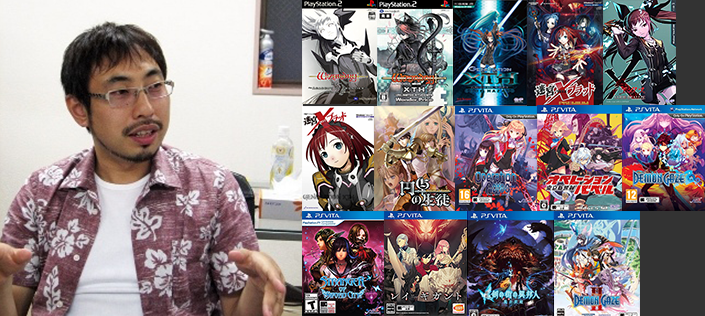The Wizardry series began in 1981 with Wizardry: Proving Grounds of the Mad Overlord, and ended in 2001 with Wizardry 8, with its iconic first-person dungeon exploring and turn-based combat being all but dead. At least in the West…
In Japan, however, the Wizardry series is alive and spawns over 30 titles across all platforms, including mobile games and MMORPGs. Plus, it inspired countless other “DRPGs” – Dungeon RPGs, as they are called – such as Etrian Odissey, Dungeon Travelers, Class of Heroes, Dark Spire, Shin Megami Tensei: Strange Journey, Elminage, etc…
Motoya Ataka has a long tradition with those. He began at the source, working in Wizardry Empire games in the early 2000’s, then eventually directing his own spin-off at Michaelsoft: the Wizardry Xth series, which moved the setting from medieval fantasy to modern day Japan.
The game was well-received, but Michaelsoft closed down, so Ataka-san took his team, called “Team Muramasa”, and founded is own company, Experience Inc.
There he created the Generation Xth trilogy, a “spiritual sucessor” to Wizardry Xth, and just kept pushing out DRPGs: Labyrinth Cross Blood, Operation Abyss, Students of the Round, Demon Gaze, Ray Gigant and the recently localized Stranger in Sword City.
With such credentials, he seemed like the perfect person to talk about then DRPG genre, its differences to western dungeon-crawlers and the passion Japanese gamers feel for this classic RPG style. So, without further ado, here’s the interview:
Ataka-san, you created many Dungeon RPGs, a type of game that isn’t made anymore in the West but is still very popular in Japan. What is your favorite aspect of this style of game?
I believe the genre lends itself easily to various surprises and innovations born from the activity (interactivity) of the user, the path to and realization of a goal, and lucky occurrences and unforeseen accidents. So, I would say the answer is to evoke such things through game design.
Strangers in Sword City is the first of your games to be released in English on Steam, and was very well received by critics and fans. Are you surprised by this reception? Do you plan to bring more games to Steam?
While we were surprised by how well the game seemed to have been received, we are very happy to see that players are enjoying themselves! In regards to new releases on Steam we currently have nothing scheduled.
A new, updated version of Stranger in Sword City was recently released in Japan, featuring three new classes and many other improvements. Are there any plans to also update the English Steam version?
In regards to New Interpretation: Stranger of Sword City, this title was created from the feedback collected from our players who filled out a questionnaire here in Japan. If we were to do an overseas version, we would do another questionnaire and collect feedback in order to create a more enjoyable product. There are no plans to bring over the current New Interpretation: Stranger of Sword City
Some of your games were exclusive for Windows, others were exclusive for consoles. Do you think PC gamers are much different from console gamers? Do you plan the game’s design around those differences?
At the time when Generation Xth was released to the Japanese users, I do not believe there was a large difference. In particular for both PC and console games, we do not really consciously create design differences.
I’ve read that Wizardry V is your favorite Wizardry game. It was a game with many hard puzzles and riddles, but your games and most Japanese DRPGs tend to avoid those. Why is that?
Titles created by our company, while not in large numbers do use some puzzles and riddles. While it is a matter of taste with titles, we would like to consider including more to the best of our abilities if a title requires such features in the future.
After Wizardry V the series radically changed – Wizardry VI removed the town, Wizardry VII had a large open world map and Wizardry 8 was fully 3D. However, Japanese DRPGs still mostly follow the Wizardry I-III formula. Why you think that is? And would you like to one day make a game influenced by these other games, like an open-world map or a fully 3D DRPG?
Many of our fans love the traditional DRPG style, so as a developer, I want to meet those expectations. Furthermore, there already exist many new high-end interpretations of the DRPG genre, so I mostly want to admire it from a user’s standpoint.
All your DRPGs are turn-based. Have you ever thought of doing a real-time one, like Dungeon Master or Might & Magic VI?
Personally it is a game that I like, therefore if chance allows it I would like to try my hand at making one.
Do you still play Western RPGs? Which are your favorite recent ones?
Although it was a while back, I managed to clear Fallout 4. I really enjoyed how it linked the modern setting that helped immerse the player in the game world.
Finally, the RPG Codex interviewed Robert Woodhead, creator of Wizardry, and he said he has no idea why Wizardry is so popular in Japan. What would you tell him?
I remember when I played Wizardry as a child, the game was so intellectual – and the people who played it seemed so cool – that it completely blew away the stereotypical image of the video game otaku. During the genesis of the Japanese RPG (the Famicom’s prime), such an awe-inspiring game coming from the West shook up the Japanese RPG genre and would captivate gamers’ hearts for years to come.
My deepest thanks to Ataka-san for his time, and for the Experience Inc. staff members who made this interview possible.


fallout 4, absolute decline.
LikeLiked by 1 person
Popamole, he’s talking about the atmosphere
LikeLiked by 1 person